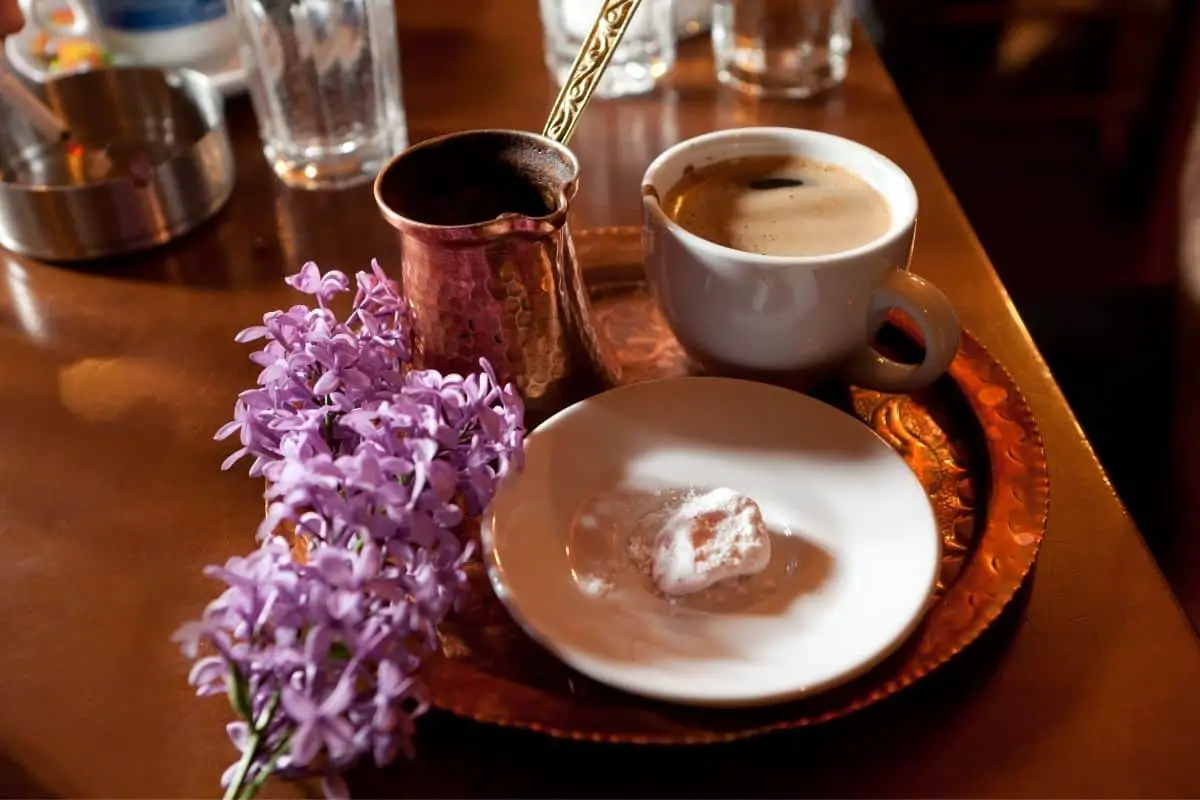As a coffee drinker, you’ve probably met a friend for coffee, be it for catching up, brainstorming, or studying. Coffee shops, for many decades now, are great places for both casual and business meetings.

In Greece, the Greeks take coffee breaks seriously. The Greeks enjoy long coffee breaks. In Greece, there’re two kinds of cafes, including kafeneio (classic Greek cafes) and kafeteria (large, modern cafes). Kafeterias typically attract younger patrons. Most Kafeterias transform into pubs at night. Kafeneios typically attract older patrons.
Regardless of the café you opt to visit, they all serve traditional Greek coffee.
The History behind Greek Coffee
Greek coffee, known as Ellinikos kafes in Greek, is a form of traditional Turkish coffee. The coffee is prepared the same way it was prepared many centuries ago, even during the tough Ottoman rule in Greece, between 1453 and 1821.
Although this type of coffee is “Turkish”, the Greeks don’t call it Turkish coffee. The Grecian culture finds anything “Turkish” as sore. After Greeks were forced out of Turkey’s largest city, Istanbul, by the Turks in 1955, Greeks consider “Turkish” as an insulting word. Thus, they expunged it from their daily life and vocabulary. As a result, they started referring to “Turkish coffee” as “Greek coffee”. The term “Greek coffee” is now permanently used in Greece since 1974.
Three Loumidis brothers brought ground coffee beans to Greece in 1919 after working in coffee roasting houses for some time. They started selling the ready coffee to the general public by 1923. They established a company as a family. The company still boasts of having a good reputation for authentic coffee to date.
Another family, known as Samourkas, opened a small coffee shop in Athens in 1923. In 2017, the Samourkas became the second biggest exporter of ground coffee from Greece.
Customs Related to Greek Coffee
There’re three customs related to Greek coffee including:
- Fortune Telling
If you’ve watched the Harry Potter film series or read the Harry Potter novel series, then you likely know Professor Trelawney. Trelawney is a Divination teacher in the Harry Potter series. She read fortunes contained in tea leaves once they settle in tea cups. While Trelawney’s practices revolve around tea in books, it’s a real practice in Greek coffee culture.
The coffee grounds that settle in a mug of Greek coffee created an interest in fortune-telling among the Greeks. Actually, some Greeks read coffee like a professional.
As per the Greek fortune telling custom, upon finishing your cup of coffee, swirl the cup around such that the sediment spreads and covers the inside walls of the cup. Next, place a saucer over the cup. Then turn over the cup. Allow for some time for the grounds to drain along the walls of the cup. Next, flip the cup back. Once done, let someone else look into the cup to interpret what they’ve seen.
Many kinds of symbols and shapes may be interpreted including initials, forks, and rivers. The bottom of a cup or mug represents experiences or people from one’s past whereas the middle section represents current happenings. The top section represents the future.
- Weather Prediction
Greek coffee lovers believe that a coffee cup or mug can predict the weather quite accurately. In case bubbles form at the center section of a cup, good weather is coming soon. However, if the bubbles are forming along the edges, the weather is likely to be grey and dark, which indicates the coming of either snow or rain.
- Pour One Out
In Greece, some people believe that by pouring some coffee from their cup over the ground, they’ll be lucky and find money.
Recipe for Brewing Greek Coffee
Classic Greek coffee comprises a heavy and strong brew. It features a thick foam over the top when served. It’s brewed with a briki coffee pot. It’s served in demitasse cups without filtering the grounds. The grounds settle at the bottom. Thus, Greek coffee is made for slow enjoyment. You’ll savor every sip when taking Greek coffee. If you’re serving a crowd, each person should also get ice water in a glass.
Supplies needed:
- Cold water
- Demitasse cups
- Finely ground Greek coffee
- Briki (available in sizes 2, 4, and 6 cups)
Instructions:
Step 1– Add cold water into a demitasse cup until full. A full demitasse cup is about ½ of a regular cup. Pour the water into the briki.
Step 2– It’ll need some experimentation to brew the best Greek coffee as per your sweetness and flavor preferences. There’re 4 basic ways of brewing Greek coffee including:
- Heavily sweetened and extra strong (or vary glykos) – In this case, add 3 teaspoons of sugar and 2 teaspoons of coffee.
- Sweetened (or glykos) – In this case, add 2 teaspoons of sugar and 1 teaspoon of coffee.
- Semi-sweetened (or metrios) – In this case, add 1 teaspoon of sugar and 1 teaspoon of coffee.
- Unsweetened (or sketos) – Only add 1 teaspoon of coffee.
Step 3– Turn on the burner and set the heat to exactly medium-low. Next, place your briki on the burner. Stir the contents until fully dissolved. Don’t stir again. It’ll soon foam. Note that the foam will rise quickly before the brew boils.
Step 4– Allow the foam to reach the top of the briki. Once done, remove it from the burner and start serving the brew. First, serve the foam in equal portions to demitasse cups. Next, serve the rest of the brew. You should pour the brew carefully to avoid mixing up the foam.
Step 5– Sip the brew and enjoy.
Related Articles